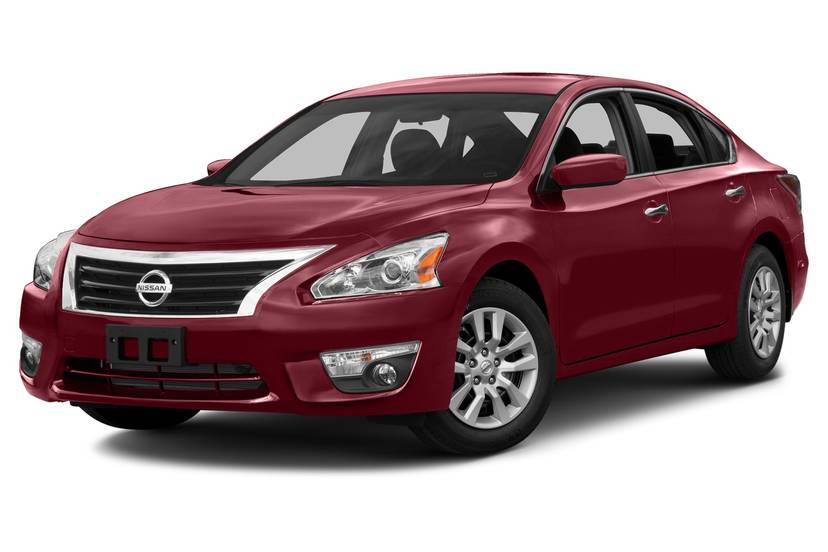
Upon entering the backseat of Nissan’s 2013 Altima for the first time, my daughter exclaimed, “This is just what a limousine is like on the inside! At least, this is what I imagine a limousine is like on the inside!” The role of chauffeur was easily tackled during my week in the Altima.
I don’t always love that part of my job description as a mom to two school-aged kids, but it was, in fact, comfortable and doable in the Altima, despite my initial concerns about its size.
It’s really not that big a leap to imagine the 2013 Nissan Altima as the car of choice for chauffeurs — both professionals and parents. The Altima is a large midsize sedan, and it easily accommodated my family of four and our daily lives.
The redesigned Altima has a 2.5-liter four-cylinder base engine, but my test car had the optional V-6. Little engine, wind or road noises are heard in the cabin. Both engines are paired with continuously variable automatic transmissions, and I’m happy to report there’s not the typical whining from them.
The CVT is quiet and seamless. However, anyone who enjoys a bit of engine noise and the jolt when an automatic transmission shifts gears will not like this. Anyone who enjoys smooth power and a quiet cabin will be impressed.
The 2013 Altima has a starting price of $22,280, including a $780 destination charge. My test car, an Altima 3.5 SV cost $29,425.
EXTERIOR
The 2013 Altima looks leaner but not quite meaner than its 2012 self. The redesigned midsize sedan is sinewy and upscale, thanks to a few chrome details.

As for getting in and out, younger kids will appreciate the lightweight doors and low step-in height. Parents will like that the doors don’t open so wide as to be a hazard to cars parked next to the Altima. What parents may get tired of is ducking down under the low roofline to get young ones buckled into child-safety seats. This lends itself to possible head-bonks and backaches.
As my kids are moving out of their booster seats, I’m realizing that now my concerns shift more to trunk space. Strollers have strolled out of my daily life and in have wandered hockey bags, ski gear, small suitcases, sleeping bags and pillows. Jumbo boxes of diapers have long disappeared and in their place are science fair dioramas. As the growth spurts of two kids kick in, I’m buying more groceries. The Altima’s trunk space accommodated these older-kid necessities, though the hockey stick had to go in the backseat. Incidentally, the rear seats fold 60/40 in case I needed more stick space.
The 2013 Altima has a base 182-horsepower, 2.5-liter four-cylinder engine that gets an EPA-estimated 27/38 mpg city/highway. My test car, the Altima 3.5 SV, had the optional 270-hp, 3.5-liter V-6 engine that gets 22/31 mpg. Both engines use regular gas.

SENSE AND STYLE
Family Friendly (Not Really, Fair, Great, Excellent): Great
Fun-Factor (None, Some, Good Times, Groove-On): Some
INTERIOR
The Altima’s interior is well thought out and hospitable, and it uses a less-is-more approach, resulting in an uncluttered look.

The fabric upholstery looks lush and inviting, and the driver’s seat is comfortable, though lacking in significant seat bolsters. There’s an open cubby with a grippy liner that sits in front of the gearshift and is used for devices or other small objects, so you don’t have to use the cupholders for your lip balm and small pack of tissues. This spot in the Altima has a charger and a USB port located in it.
The Altima also has two independent cupholders instead of the usual rectangular space split by a plastic insert with semicircular flaps. This increased the space between lids on to-go coffee cups and kept the lids from loosening or popping off. Thank you for fixing this minor problem, Nissan.
The center stack is clearly marked, and the multimedia system is easy to use. Now that these systems have been around a while, they seem to be getting more and more refined. There was little redundancy in the Altima’s system; I appreciated that there weren’t five ways to do the same thing.
The backseat has an amazing amount of legroom, and there’s a fold-down armrest that keeps cupholders within easy reach of the younger set.
IT’S THE LITTLE THINGS THAT COUNT
Storage Compartments (Puny, Fair, Ample, Galore): Ample
Cargo/Trunk Space (Puny, Fair, Ample, Galore): Ample
SAFETY
The 2013 Nissan Altima has received the top safety rating of five stars overall from the National Highway Traffic Safety Administration. It earned five stars out of five in frontal and side crash tests and four stars in a rollover crash test. It hasn’t been tested by the Insurance Institute for Highway Safety.
Installing a child-safety seat in the Altima wasn’t as easy as most parents would like. It has two sets of lower Latch anchors, but some of the anchors are in the same area as the seat belt buckles, creating a mash of buckles, belts and connectors. Not fun. The fixed head restraints made installing a forward-facing convertible awkward. Booster seats fit perfectly on the second row’s bench because there was no bolstering to create havoc. For more on safety-seat fit, check out Cars.com’s Car Seat Check.
The 2013 Altima has standard front-wheel drive, four-wheel-disc antilock brakes, an electronic stability system with traction control, active front head restraints and six airbags, including side curtains for both rows. An additional standard feature is the Easy-Fill Tire Alert system that will flash the Altima’s hazard lights as you are filling the tires and then gives you a “friendly beep of the horn” when the tire is full. Brilliant.
Blind spot and lane departure warning systems as well as moving object detection when in Reverse are optional.
Get more safety information about the 2013 Nissan Altima here.







































